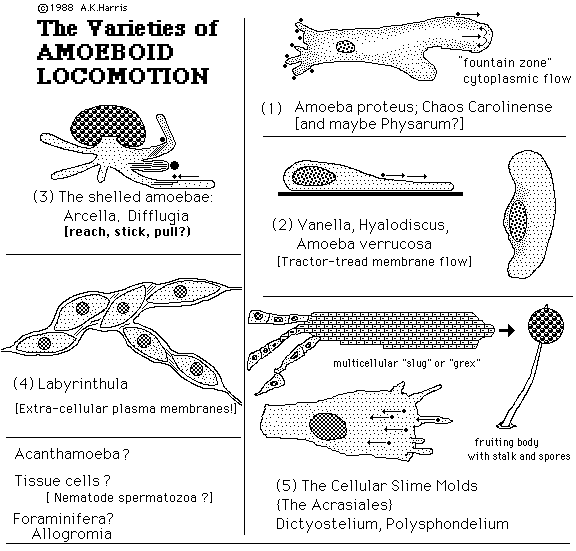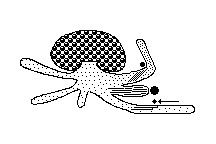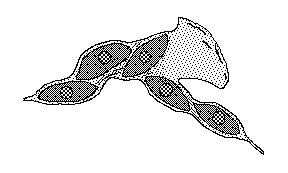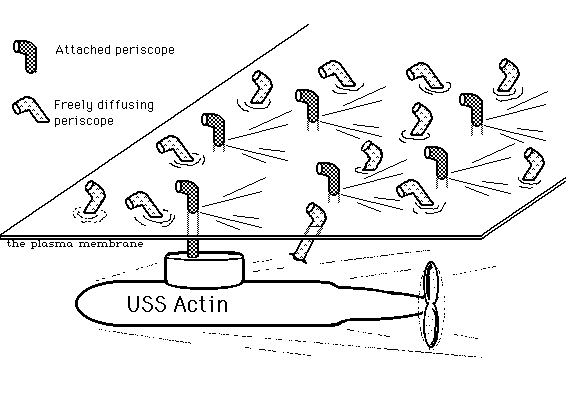
Amoeboid locomotion includes around a dozen different means of propulsion, most of which use forms of actin and myosin, and a few of which depend on cytoplasmic flow.
The two species Amoeba proteus and Chaos carolinese (discovered in this department by H. V. Wilson) are used the most in teaching laboratories. But that is because they are the fastest, not because they are typical.

I) Amoeba proteus; & also Chaos carolinense
Cytoplasmic flow. ("Fountain Zone")
Sol <--> Gel interconversion
"Sol" more liquid-like behavior of cytoplasm; flows up the center of a gel-like tube of stiffer cytoplasm.
Rear contraction theory of Mast; Fountain-zone theory of Robert Allen.


These have rapid cytoplasmic flow. In fact, most research papers about them are really attempts to understand how this flow works. But it is not so clear how their cytoplasmic flow causes movement of the cells (although it definitely does!) This "gelling" of amoeba cytoplasm is caused by polymerization of cytoplasmic actin
The "gelling" of amoeba cytoplasm is caused by polymerization of cytoplasmic actin
video of Amoeba proteus moving, showing cytoplasmic flow
video of an amoeba engulfing some food
Forward transport of marker particles attached to the outer surface of the plasma membrane;
And rearward transport of attached particles where pseudopodia are retracting.
II) Rolling Amoebae (a name that I invented, for lack of anything better.)

Adhering marker particles are pulled forward across the top, and rearward on the bottom.
(The plasma membrane moves in the pattern of a tank tread).
The forward movement of marker particles is exactly twice as fast as the forward movement of the front edge of that cell. This is exactly the speed of the forward movement of a tank tread.
III) Shelled amoebae. Difflugia and others.
These secrete and/or build hard little shells, sort of like microscopic snail shells. These really do reach out long narrow cytoplasmic protrusions, which stick to anything, and contract, pulling the cell forward, and pulling smaller objects rearward.

Difflugia amoebae use pseudopodia to reach out & pull in tiny sand grains, which they build into a hollow ball, inside of which the amoeba lives. Some other genera secrete transparent hollow spheres.
When being protruded outward, each small pseudopod has a fountain-zone pattern of cytoplasmic flow and sol-gel conversion. When these pseudopodia touch anything, they adhere and are somehow induced to contract.
This cycle of Protrusion - Adhesion - Contraction pulls the cell forward and pulls particles rearward.
Many or most textbooks claim that tissue cells (especially tissue culture cells) crawl by such a cycle of
Protrusion - Adhesion - Contraction; but you will see in a video that they really don’t.
IV) Labyrinthula
Mostly live in salt water. Cause a major disease of sea grasses & major ecological changes.
Secrete extracellular layers of plasma membrane. (called "slime-ways")
Inner-most cells are football-shaped, and are bounded by a stiffer plasma membrane, outside of which they secrete more layers of (flexible) plasma membrane.
These outer layers of plasma membrane were long believed to be non-living mucous slime.
Despite the ability of the extracellular layers of plasma membrane to extend and crawl, by itself, hundreds of microns beyond where any of the football-shaped "cells" have moved, scientists resisted the idea of multiple layers of plasma membrane. Everybody assumed that either the "footballs" were nuclei and the "slime-ways"
were living cytoplasm, or alternatively that the "slime-ways" were extracellular mucus, and the "footballs" were ordinary cells. Eventually, electron microscopy and time-lapse films proved that the extracellular membranes and cytoplasm were alive.
99% of biologists don't know that labyrinthula exist, or anything like them.
Labyrinthula are very common in the ocean, and cause diseases in sea grasses, and perhaps other organisms. Fresh water and land species also exist. Some of the latter attack golf courses!
There is a Wikipedia article about Labyrinthula, which in my opinion isn't very good, has no illustrations, but does have a good bibliography. David Porter, at the U of Georgia has done the best research on these interesting creatures.

An excellent YouTube video about Labyrinthula: https://www.youtube.com/watch?v=yFK8D41VvLY
V) Physarum (Syncytial slime molds)
Highly multinucleate. Gigantic in comparison to Amoeba proteus!
Millimeters up to several centimeters in length.
Found in rotten wood and soil, and not under water.
Extremely fast and dramatic cytoplasmic flow
Also alternating contraction-relaxation of whole amoebae.
video showing spreading and engulfment of oatmeal in a culture of Physarum
VI) Dictyostelium: (and other Cellular Slime Molds)
Move either as individual cells, phagocytizing bacteria, and then as multicellular "slugs". This aggregation is induced to occur when cells "attract" each other by chemotaxis; the attractant substance (for D. discoideum) is cyclic AMP.
The amoebae differentiate to form a stalk and spores. (in about the proportions of a coconut palm tree)
Fruiting bodies (meaning tree-like combination of stalk plus spores] can be as big as several hundred thousand amoeboid cells, and as small as 14 cells. An extreme example of dilation symmetry, comparable to what Driesch discovered with larvae of starfish and sea urchins (Echinoderms) 16-fold One Thousand-fold.
Dictyostelium cells move as individuals, phagocytizing bacteria, and then as multicellular "slugs". This aggregation is induced to occur when cells "attract" each other by chemotaxis; the attractant substance (for D. discoideum) is cyclic AMP.
video of Dictyostelium amoebae
Movement of animal cells
White blood cells, nerve cells, mesenchymal cells, etc, etc, etc. move in a similar way to Dictyostelium amoebae.
video of a leucocyte (white blood cell) moving by amoeboid locomotion among red blood cells
This video was shown at the beginning of the lecture on October 2nd.
Particle Transport
animation of particle transport
Almost certainly it results from traction being applied to small, moveable objects.
Actin molecules polymerize into fibers along the front-most parts of cells, and
these fibers get pulled rearward by active sliding along myosin fibers in more rearward and central parts of the cell.
Traction results from physical connections through the fluid mosaic structure of the plasma membranes. The locations where traction forces are exerted are several microns behind the leading edge. In some cells, filopodia are part of this exertion of traction.
Retrograde surface transport also occurs in Dictyostelium and other slime molds.
There are more different kinds of amoeboid organisms, such as foraminifera, and others waiting to be discovered.
* wound closure and healing
* invasiveness of cancer cells (including penetration into and out of blood vessels in metastasis)
* (Hypothetical) Use of cell traction to realign type I collagen to form tendons, ligaments and skeletal muscles
What exerts the forces in the crawling locomotion of tissue cells?
Actin polymerizes (molecules of actin protein diffuse through the cytoplasm, and are somehow induced to polymerize ("gel?") along some parts of the edges of each cell.
This polymerization of actin pushes forward thin stiff flat sheets of cytoplasm called "lamellipodia"
(And sometimes rod-like filopodia and small, hemispherical "blebs" or lobopodia.)
Sheets of polymerized actin get pulled rearward toward the middle of each cell.
Anything that adheres to the outer surface of the plasma membrane gets pulled rearward.
(Including micron-sized particles of styrene, metal, or anything)
This is called "retrograde transport."
(Particles get pulled rearward on both the "top" and the "bottom" of crawling cells.)
Cells cultured either on gels or on sheets of rubber pull rearward and distort these materials.
The force that moves the particles and distorts the gels and rubber is called "traction".
Traction results from molecular links through the membrane, connecting flowing actin to outside objects.
Crawling Locomotion of Tissue Cells
Important examples of crawling locomotion of cells:
* many processes in embryonic development


 >
>